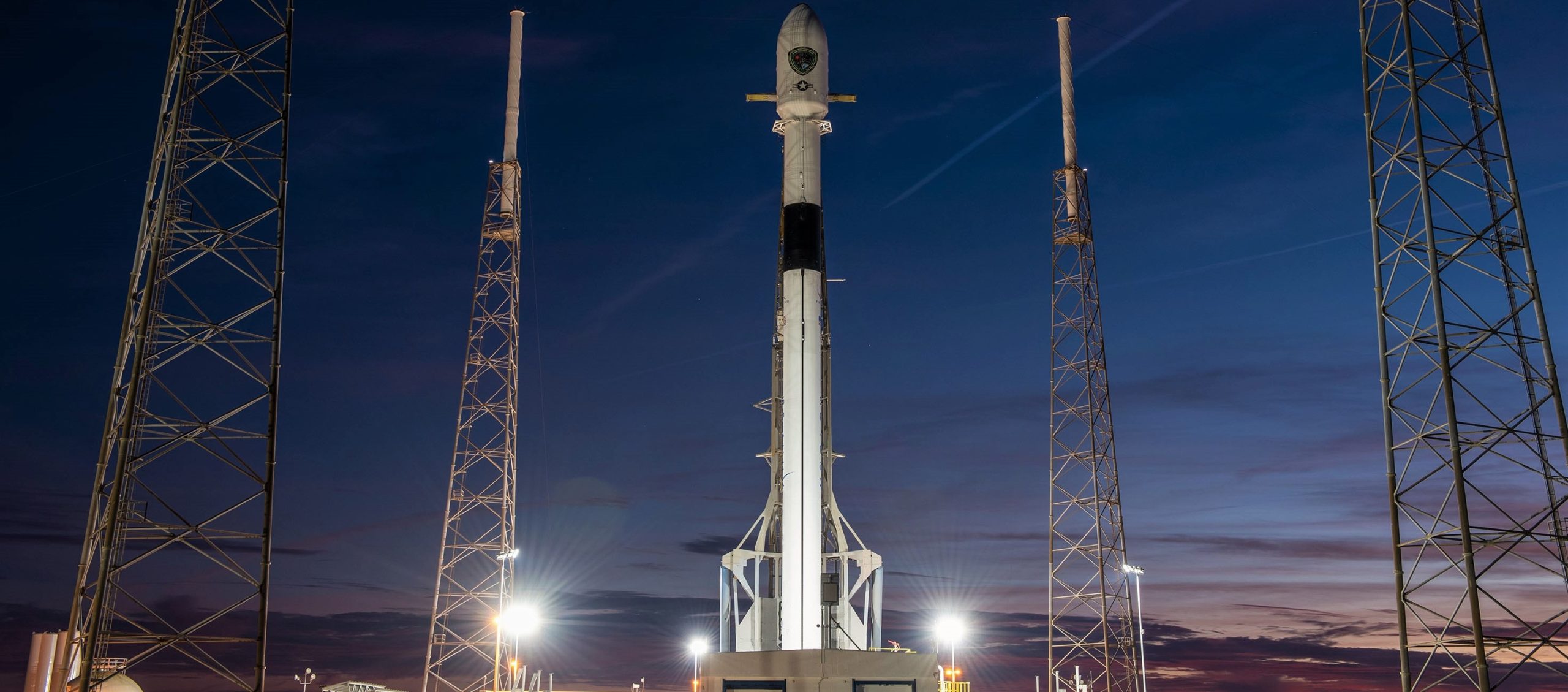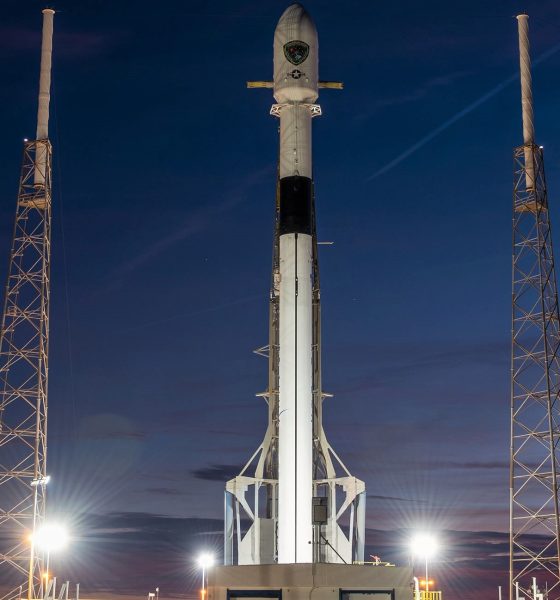

SpaceX
SpaceX set for expendable Falcon 9 Block 5 launch attempt after 48 hour scrub
Following a reported bug with Falcon 9 booster sensors that triggered a launch abort on the morning of December 18th, SpaceX has mitigated those problems and is ready to try again, hopefully placing the first of 10 new USAF GPS III satellites into orbit shortly after a 9:03 am EST (14:03 UTC) liftoff on December 20th.
Aside from being the first time SpaceX has launched a dedicated USAF mission won through a competitive procurement process, the launch of GPS III Space Vehicle 1 (SV01) will also be the first time SpaceX has intentionally expended a new Falcon 9 booster since July 2017, as well as the first time ever that a Falcon 9 Block 5 booster will be expended without attempting to land.
Team is working toward launch of GPS III SV01 tomorrow, December 20. Weather remains a challenge; currently forecasted at 20% favorable during the 26-minute launch window which opens at 9:03 a.m. EST, 14:03 UTC.
— SpaceX (@SpaceX) December 20, 2018
Standing vertical at SpaceX’s Launch Complex 40 (LC-40) pad, Block 5 booster B1054 looks undeniably incomplete or just off without grid fins and landing legs installed, like toast without butter or a Tesla with a V8 in place of its electric motors. The fact that Falcon 9 B1054 is a brand-new booster simply throws salt on the wound. However, the expendable configuration does serve as a reminder that, when it really comes down to it, SpaceX’s launch customers with as much sway as the Air Force ultimately have a major (if not final) say in the rocket’s trajectory.
If a customer demands an almost ridiculous level of redundancy, SpaceX likely has little to no say in that decision, even if it means that a brand new Falcon 9 Block 5 booster – designed to launch anywhere from 10-100 times in its lifetime – will have to be disposed of in the ocean after just one. While the performance-based decision to expend Falcon 9 appears to be far more of a security blanket than a practical necessity, it does still serve as a reminder that some exceptionally heavy payloads and/or high-energy orbits will inevitably preclude Falcon 9 or even Falcon Heavy from attempting booster landings. Down the road, major NASA or national security payloads will likely continue to demand expendable configurations, at least until BFR (Starship/Super Heavy) can take over from Falcon 9 and Heavy.
A sunny afternoon at SLC-40 — Following today’s scrub, SpaceX graciously let us photographers revisit the pad to check on our cameras ahead of tomorrow morning’s launch of Falcon 9 and GPS III. pic.twitter.com/7vzIDl9W9p
— John Kraus (@johnkrausphotos) December 18, 2018
Although SpaceX does appear to be serious Thursday’s launch attempt, the weather conditions are far from desirable thanks to the forecasted presence of “Electric Field, Cumulus/Thick Cloud, Disturbed Weather”, as well as the likelihood of strong upper-level winds near the Florida coast. With just a 20% chance that weather conditions will permit a launch and a brief 26-minute window of opportunity, there is little to no wiggle room for SpaceX to wait for a figurative break in the clouds, and another scrub seems extremely likely.
If the weather does force SpaceX to call off Thursday’s attempt, additional opportunities appear to be available on Friday (60% favorable) and Saturday (80% favorable). For now, however, Falcon 9 B1054 appears to have bought itself a few extra days to continue being an intact and (mostly) dry rocket. Catch the watch live at the link below.
For prompt updates, on-the-ground perspectives, and unique glimpses of SpaceX’s rocket recovery fleet check out our brand new LaunchPad and LandingZone newsletters!

Elon Musk
Elon Musk’s Biggest Revelations on AI, Robots, and the Future of Work from the Moonshots Podcast

Elon Musk’s appearance on the Moonshots with Peter Diamandis podcast was packed with bold predictions, candid admissions, and surprising tech insights. The nearly three-hour conversation covered everything from artificial intelligence to humanoid robots, geopolitics, and the future of work. Here are the top 10 most intriguing takeaways:
-
Aggressive AGI Timeline Predictions
Musk offered a detailed view on when artificial general intelligence (AGI) could emerge, suggesting it may arrive sooner than many expect, emphasizing both transformative potential and risks.
-
U.S. vs. China in the AI Race
He discussed the strategic competition between the United States and China over AI development, noting that geopolitical dynamics will shape how and who leads in the next decades.
-
Future of Job Markets
Musk touched on how AI and automation could reshape employment, predicting massive boosts in productivity alongside potential disruptions in traditional work structures.
-
Clean Energy Transition
A recurring theme was the role of clean energy in future economies, with Musk reiterating the importance of scaling sustainable power generation and storage.
-
Humanoid Robots Are Coming
On the podcast, Musk elaborated on Tesla’s work on humanoid robots, hinting at timelines and applications that go beyond factories to general-purpose assistance.
-
Tesla Roadster “Last Human-Driven Car”
Outside the core discussion topics, Musk teased features of the upcoming Tesla Roadster — calling it “the best of the last of the human-driven cars” and suggesting safety won’t be its main selling point.
-
The Role of AI in Clean Energy and Robotics
Linking AI to both energy optimization and robotics, Musk explained how smarter systems could accelerate decarbonization and task automation across industries.
-
U.S. Innovation Leadership
Musk argued that maintaining American leadership in key tech sectors like AI, space, and robotics should be a national priority, with thoughtful policy and investment.
-
Job Creation vs. Job Elimination
While acknowledging automation’s disruptive effects, he also outlined scenarios where new industries and opportunities could emerge, particularly in AI, space, and advanced manufacturing.
-
Long-Term Vision for Humanity
Throughout the conversation, Musk revisited his long-term philosophical views — including a belief in humanity’s responsibility to become a multi-planetary and technologically empowered species.
Whether you agree with Musk’s optimism or not, the podcast offers a window into the thinking of one of the most influential figures in tech today, in and why his visions continue to spark debate and inspiration.
Elon Musk
Starlink achieves major milestones in 2025 progress report
Starlink wrapped up 2025 with impressive growth, adding more than 4.6 million new active customers and expanding service to 35 additional countries, territories, and markets.

Starlink wrapped up 2025 with impressive growth, adding more than 4.6 million new active customers and expanding service to 35 additional countries, territories, and markets. The company also completed deployment of its first-generation Direct to Cell constellation, launching over 650 satellites in just 18 months to enable cellular connectivity.
SpaceX highlighted Starlink’s impressive 2025 progress in an extensive report.
Key achievements from Starlink’s 2025 Progress
Starlink connected over 4.6 million new customers with high-speed internet while bringing service to 35 more regions worldwide in 2025. Starlink is now connecting 9.2 million people worldwide. The service achieved this just weeks after hitting its 8 million customer milestone.
Starlink is now available in 155 markets, including areas that are unreachable by traditional ISPs. As per SpaceX, Starlink has also provided over 21 million airline passengers and 20 million cruise passengers with reliable high-speed internet connectivity during their travels.
Starlink Direct to Cell
Starlink’s Direct to Cell constellation, more than 650 satellites strong, has already connected over 12 million people at least once, marking a breakthrough in global mobile coverage.
Starlink Direct to Cell is currently rolled out to 22 countries and 6 continents, with over 6 million monthly customers. Starlink Direct to Cell also has 27 MNO partners to date.
“This year, SpaceX completed deployment of the first generation of the Starlink Direct to Cell constellation, with more than 650 satellites launched to low-Earth orbit in just 18 months. Starlink Direct to Cell has connected more than 12 million people, and counting, at least once, providing life-saving connectivity when people need it most,” SpaceX wrote.
Elon Musk
Starlink passes 9 million active customers just weeks after hitting 8 million
The milestone highlights the accelerating growth of Starlink, which has now been adding over 20,000 new users per day.

SpaceX’s Starlink satellite internet service has continued its rapid global expansion, surpassing 9 million active customers just weeks after crossing the 8 million mark.
The milestone highlights the accelerating growth of Starlink, which has now been adding over 20,000 new users per day.
9 million customers
In a post on X, SpaceX stated that Starlink now serves over 9 million active users across 155 countries, territories, and markets. The company reached 8 million customers in early November, meaning it added roughly 1 million subscribers in under seven weeks, or about 21,275 new users on average per day.
“Starlink is connecting more than 9M active customers with high-speed internet across 155 countries, territories, and many other markets,” Starlink wrote in a post on its official X account. SpaceX President Gwynne Shotwell also celebrated the milestone on X. “A huge thank you to all of our customers and congrats to the Starlink team for such an incredible product,” she wrote.
That growth rate reflects both rising demand for broadband in underserved regions and Starlink’s expanding satellite constellation, which now includes more than 9,000 low-Earth-orbit satellites designed to deliver high-speed, low-latency internet worldwide.
Starlink’s momentum
Starlink’s momentum has been building up. SpaceX reported 4.6 million Starlink customers in December 2024, followed by 7 million by August 2025, and 8 million customers in November. Independent data also suggests Starlink usage is rising sharply, with Cloudflare reporting that global web traffic from Starlink users more than doubled in 2025, as noted in an Insider report.
Starlink’s momentum is increasingly tied to SpaceX’s broader financial outlook. Elon Musk has said the satellite network is “by far” the company’s largest revenue driver, and reports suggest SpaceX may be positioning itself for an initial public offering as soon as next year, with valuations estimated as high as $1.5 trillion. Musk has also suggested in the past that Starlink could have its own IPO in the future.








